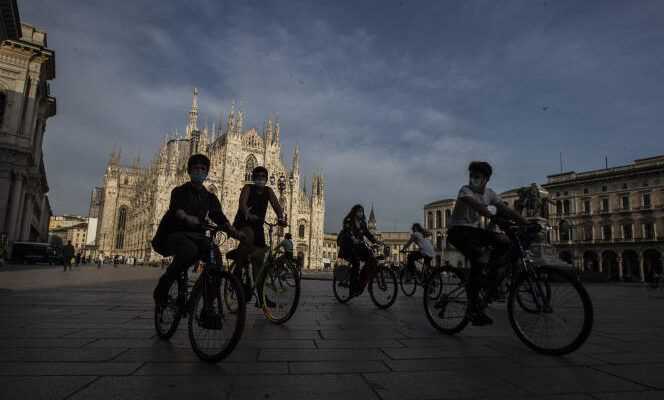All roads lead to Rome. Including when they are with limited traffic. In 45 BC, tired of the chaos generated by traffic jams in the alleys of the Eternal City, Julius Caesar decreed the ban on tanks. After sunrise and until the edge of dusk, wagons and horses are no longer tolerated inside theurbs. The Imperator’s law anticipates recent measures taken against congestion and pollution in cities, and in particular restricted traffic zones (ZTL). These have seduced several cities in Germany, Switzerland, Belgium, and are now invited to France: after Nantes, Paris plans to exclude classic car traffic in its center, from the second half of 2022,.
To understand the functioning, the advantages and the limits of this restriction of movement, Italy remains a privileged territory. Most of the cities of the peninsula have a space of this type, and Milan holds the record for the largest ZTL in Europe: 72% of the territory of the Lombard capital, namely 128.29 km2 – much more than the area of the city of Paris – is located in a ZTL.
Unlike a pedestrian zone, the ZTL covers a fairly large area, where traffic is only allowed to certain vehicles or people, generally public transport, taxis, residents, people with disabilities, emergency services, delivery people. The rise of this system is linked to the wealth of Italian heritage. Archaeological sites blackened by exhaust pipes, statues eaten away by pollution… the ZTL are born as a solution to protect historic centers.
“Panic in the streets”
“The very first one appeared in Tuscany, in the Piazza del Campo de Siena, in 1962. The square, where the famous Palio was racing, has a curved shape that does not support car traffic”, recalls Luca Tamini, professor of town planning at the Polytechnic of Milan. Gradually, ZTLs are becoming more widespread, in particular in Lombardy, where pollution levels are among the highest in Europe. “The arrival of the ZTL in Milan in 2012 is primarily due to the desire to fight against the city’s air pollution”, notes Arianna Censi, in charge of mobility and transport for the city hall of Milan. The measure is far from being consensual.
“The day the ZTL took effect, it looked like we were preparing for Armageddon, there was panic in the streets. The residents of the city center almost came to blows with Pierfrancesco Maran, then mobility manager of the town hall. But everything went very well ”, says Federico Parolotto, founder of Mobility in Chain. Even traders, who fear a drop in their turnover with the departure of the cars, change their minds: “Within the ZTLs, the vacancy rate on the ground floors is falling: this means that businesses are more resistant to areas with limited traffic. The flow of passers-by generates commercial activity. So much so that today, the big brands that are setting up in Milan are asking to be inside the ZTL ”, details Luca Tamini.
In 2018, when the European Commission seized the Court of Justice of the EU concerning Italy for continuous infringements of the limits in matters of air pollution, the city of Milan decided to go even further. Since February 25, 2019, a new limited traffic zone, called “Area B”, covers almost the entire city, with a ban on the movement of vehicles. vehicles the most polluting. Six months later, their transit has decreased by 13%, with 12,000 fewer passenger compartments every day. “We have released 3 million euros to finance the purchase of hybrid or electric means of transport”, emphasizes Arianna Censi.
Push to buy new
“The ZTL has improved the situation in the city center, but in the suburbs we continue to argue for a parking space. Italy is among the countries with the highest number of cars per person. Public space remains colonized by scrap metal, we are still making our way between vehicles parked when walking. The acronym of ZTL stands for engines and not to pedestrians ”, regrets Paolo Pileri, professor of town planning at the Ecole Polytechnique. “In Milan, an automobile remains parked 90% of the time on average, taking up unnecessary space. We need a real cultural change ”, admits Arianna Censi.
“By limiting access to the most polluting machines, we encourage citizens to buy new. If we want to reduce traffic, we cannot act exclusively through bans. We must campaign for alternative mobility ”, says Stefano Boeri. The architect and town planner, famous for his “vertical forests”, is working on a new concept, “the archipelago city”: “Widening the ZTL from the city center means excluding the inhabitants peripheral areas. We have to imagine a more inclusive system, with a patchwork of pedestrian-style islands in a quarter-hour city where only residents will circulate, within the limit of 10 km / h, and cyclists. These islands will be distributed throughout the metropolis, and we can take the car, bike or transport to go from one island to another. “
This article was produced as part of the conference The World Cities ” What is a city on a human scale? »Organized by The world with the support of Enedis, Toyota and the Veolia Institute
Free registration : lemde.fr/cities-16decembre
